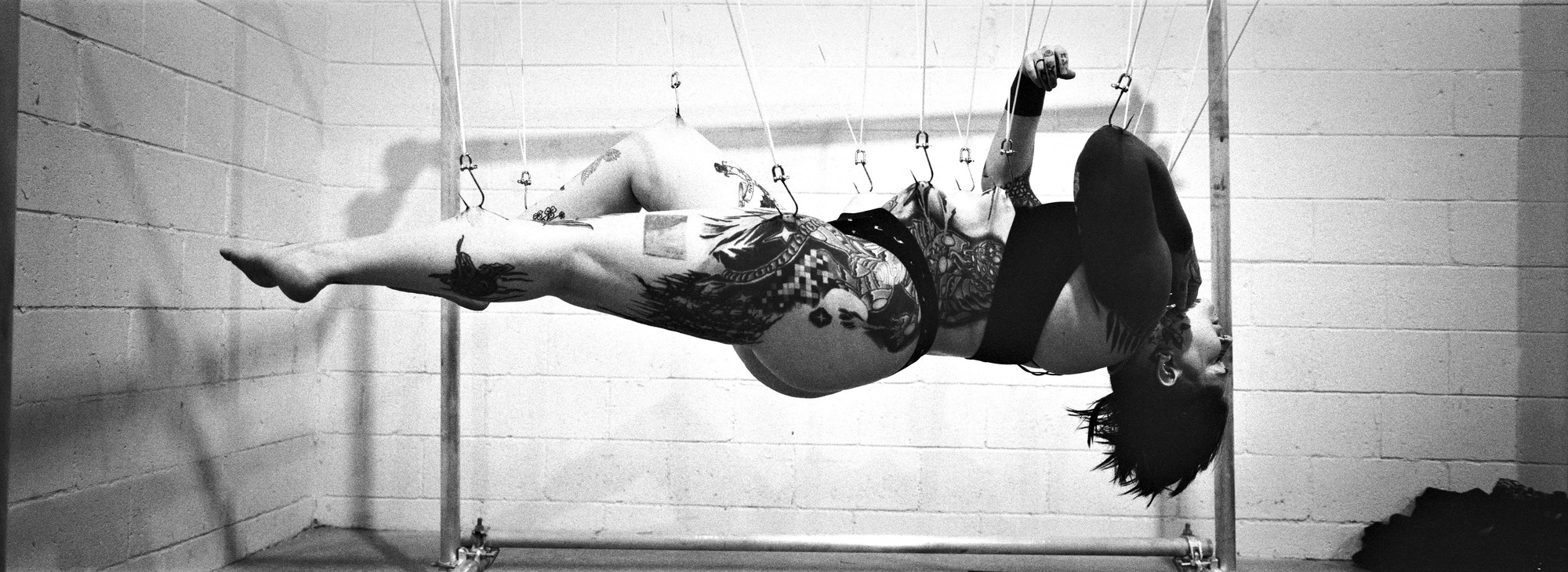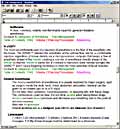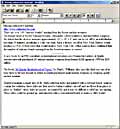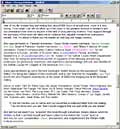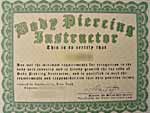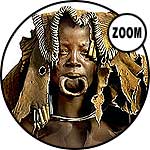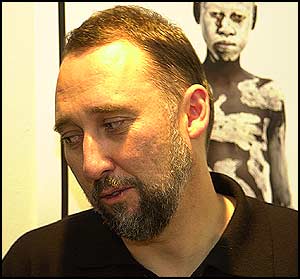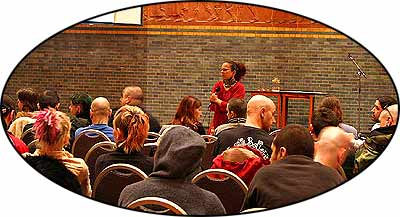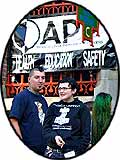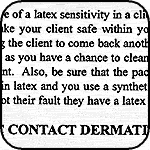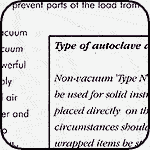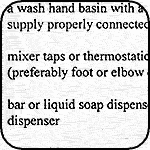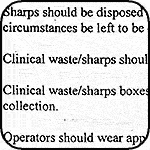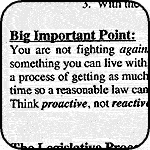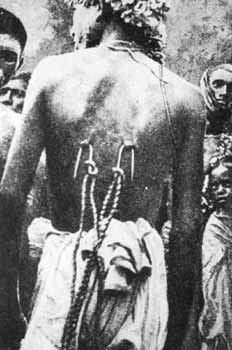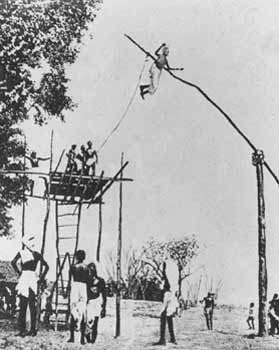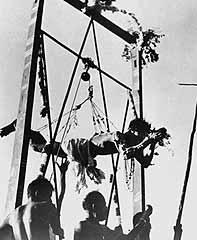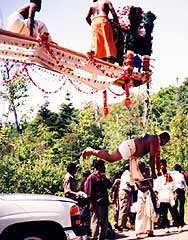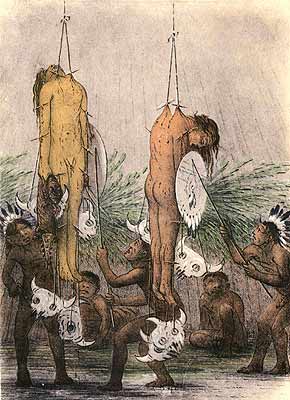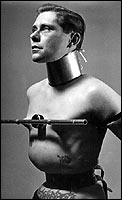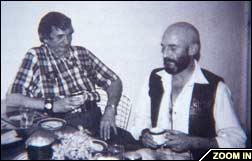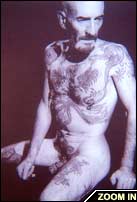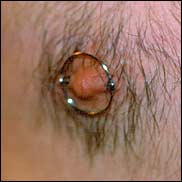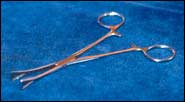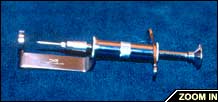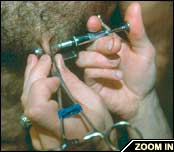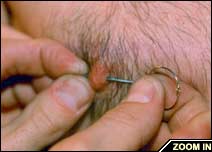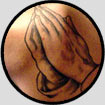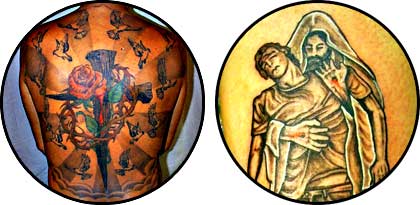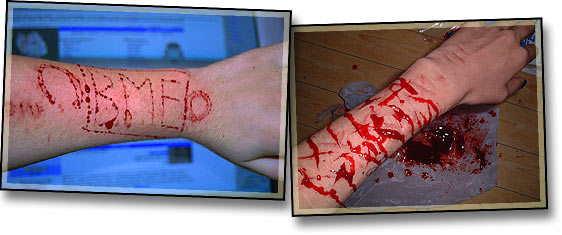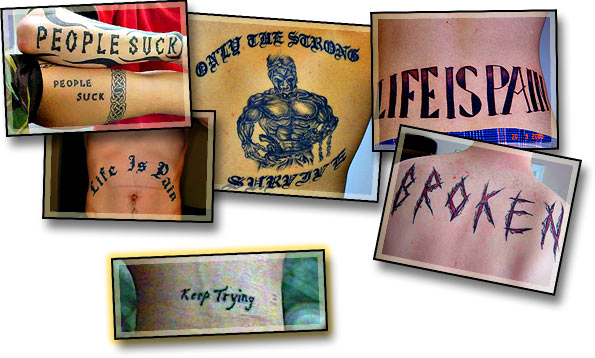 William Rafti: Piercing Visionary or Scumbag Con-Artist?
Those of you in the APP know about William Rafti because of his constant baseless attacks on APP members, his cold-calling harassment of those associated with the APP, and his relentless attacks on respected members of the piercing community such as Sky Renfro. Others may have seen his “ebook”, “The Body Piercing Encyclopedia” — which he for a time marketed as the “replacement” for the APP manual — in various online catalogs, through which he portrays himself as one of the leading minds in modern body piercing.
The truth is, William Rafti is at best an unstable asshole with a wavering grip on reality, if you’re to believe the vast majority of the piercing industry. While he’s willing to go on at length about how he’s the most important thing to happen to piercing, even using the references he provided me with, I couldn’t find a single person willing to say nice things about him or even qualify him as an expert. But still, I decided to give him a chance and asked for a copy of his ebook for review — after all, very occasionally an insane asshole does produce something of value. What I received was emphatically not something of value. In the mail I received a palm-sized plastic bag with a small unlabelled CD-R, which was wrapped in a low-quality print out informing me that I’d need Microsoft Word to view it. When I inserted the CD there was no installation process or welcome message — upon opening it I discovered that to access the documents, I’d have to copy the contents into “C:\Volume” and load the bits of the book into Word from there. When I finally got the book loaded, I found a chaotic mess of documents with constantly changing font sizes and colors, strange hyperlinks (sometimes to various Internet sites), and broken layout. It was riddled with spelling errors and grammatical confusion, and there was an abundance of unrelated files — everything from outdated shareware applications to “jokes” to chat logs of Rafti slandering various well known body modification figures. I was rather shocked at the un-professionalism of it, but still, I tried to give it the benefit of the doubt.
The feeling that you get when reading the “book” is that Rafti just downloaded every bit of body piercing related information online, and then tried to patch it together into a single project under his own name. Not only do the fonts change from “pasting to pasting”, but the style of writing changes as well, implying strongly that large portions of this book are plagiarized. In addition, I noticed that in some sections he would flip between referring to tools by their name (ie. 8mm Dermal Punch) and some sort of product code (ie. #DERM-8MM). I can think of no explanation for this other than cutting and pasting from a manufacturer’s catalog and attempting to disguise it as his own work. And then I read something familiar. William Rafti was stealing material from the old BME glossary, making minor changes to it, erasing my name, and inserting his own as the author instead! I don’t generally mind when people use BME as a basis for their own research — that’s what it’s there for. But what I do mind is when people actually claim that they wrote it. If you want to use someone else’s material, cite it properly! It’s one thing when someone plagiarizes on a school project… but for Rafti to steal BME’s material and try and criminally sell it under his own name takes some real gall. In the tables below, entries from the outdated BME glossary (Rafti did not have access to the new files in the still fledgling BME encyclopedia project at the time) are shown on the left. Entries taken from Rafti’s ebook are shown on the right — please note that in both cases I’ve not always included the entire entry for the purposes of clarity. I have highlighted direct plagiarism in yellow, and I have highlighted indirect plagiarism (where synonyms and alternate phrases have been inserted) with pink. These are only a small number of the examples that I found — my analysis suggests that the bulk of the ebook is plagiarized from various sources (not just BME). I even found some examples where he copied my typos!
|
| Blowout |
|
|
| Blowout |
|
|
| Flexible Bar Piercing |
|
|
| Flexible Bar |
|
|
| Emla Cream |
|
|
| Emla Cream |
|
|
| Epinephrine |
|
|
| Epinephrine |
|
|
| Xylocaine |
|
|
| Xylocaine |
|
|
“Lidocaine toxicity is something that can occur with way too many injections of Lidocaine. A common procedure requiring vast amounts of Lidocaine is Tumescent and Super-Wet Technique Liposuction.”
Sound familiar? It really gets me wondering whether Rafti wrote any of the text in this ebook.
| Marcaine |
|
|
| Marcaine |
|
|
| Soap |
|
|
| Hand Soap |
|
|
| Salt Soaks |
|
|
| Salt Water |
|
|
| Cyanoacrylate |
|
|
| Cyanoacrylate |
|
|
| Gauge |
|
|
| Gauge |
|
|
| Skin |
|
|
| Washing Hands |
|
|
| Nitrile |
|
|
| Nitrile, and Glove, Acceptable Quality Level |
|
|
Again, this is only a fraction of the plagiarism I discovered from BME and other sources in Rafti’s ebook. The rest are reserved for the lawyers should it come to that.
OK… So do I sue this thief into the stone age? I’m a pretty laid back guy, so I decided to do an interview with him about his book and see what he had to say — I was placing bets with myself on whether Rafti would come clean, “be a man”, and apologize, or whether he’d try and keep the lie going as long as possible.
BME: Large parts of the document are directly based on and plagiarized from my own site and from other sites. Why have you stolen other people’s work and presented it uncited and as your own? Did you really believe no one would notice?
RAFTI: “All mankind is of one author, and is one volume” – John Donne
BME: No, I’m serious. Why did you steal my articles and say you wrote them?
RAFTI: As far as anything that I am aware of that I used from others I had permission.
BME: No, you did not have permission. Why did you steal my articles?
RAFTI: With over six billion people in the world thinking millions of thoughts each there is probably no thought that you can think that hasn’t been thought before by someone else. If you mean to imply my thoughts and words are not my own then we are all guilty by circumstance of the same thing.
BME: Look, you copied word for word. Don’t try and pretend it was just a coincidence. Did you really think I wouldn’t notice?
RAFTI: No one else had a problem like this.
BME: They probably don’t know you stole their material. Maybe I should let them know? Again — why did you think you could steal my material and get away with it?
RAFTI: Nothing in my book was taken from you. Everything I know to be true tells me the opposite of what you presume.
BME: You stole entries from the glossary for example.
RAFTI: I went through every entry in your glossary with the intent of purging anything that I thought might be considered “stolen” from you. My entries were very different than what you had.
BME: Let me be clear here — I am going to publish information on your theft and it’s very clear and obvious. I’m trying to give you a chance here to come clean.
RAFTI: Stop lying. I can find no grounds for these accusations. This is war, [and] I’m making a list of names. The people caught on the losing side will face the obligatory mob reaction, same old story.
So it’s clear that Rafti is either too much of a scumbag to admit his theft, or so insane and unprofessional that he’s totally unaware of it. Either way, it was clear that this line of questions wasn’t going to get anywhere. On his website and in his book, Rafti claims to be the world’s leading expert on body piercing and states that he’s endorsed by many respected industry figures — so let’s ask him about some of those people.
BME: You’ve said on numerous occasions that industry respected individuals are endorsing your book, yet your book appears to be somewhat misleading as to who is actually supporting you — you’ve even implied that I supported it, before I’d even seen a copy! Who are your allies on this project, and who is endorsing it?
RAFTI: I have a list of people who said positive things about my book on my web site.
BME: Those are anonymous names — it’s not as if “branded bitch”, “Brandy H. (IL)”, or “name withheld at request” are people who are recognized, let alone confirmable. Seriously, tell me some people I call and check with.
RAFTI: The people who I have the most respect for in the industry support what I’m doing, including Kim Morin of Prick Magazine (I told her a thing or two she said was worth exploring), and Creeper of Starborn Tattoo in Las Vegas (I went from studio to studio in Las Vegas and could not find anyone who had his experience and knowledge).
There is also Wes of Unimax who is my biggest supporter. John Seaton of the Suffolk Country Department of Health personally told me he’d gladly endorse me. He told me that he had been waiting twenty years for something like this to happen.
David Klaus Pavin Jr (aka Kivaka) — 13 years experience — will bring much useful information to the Rafti Institute school. [And] Jim Ward is a dear friend of mine.
BME: So Jim got you into piercing?
RAFTI: He was my first contact in the world of piercing. I met him in David M.’s studio after Jim invited me to attend a piercing clinic he was offering, where they were using Betadine to sterilize and used no gloves. It turned out to be a frightening experience — I was the only heterosexual there and felt obliged to tell them so. Lots of leathermen went “oooooooh” in unison when they saw me lie down.
Jim invited me to the opening party of Gauntlet, where I also met Elayne [Angel] who personally told me and the whole room that I was “Gauntlet’s second customer, yay!”
OK, time to make some phone calls and emails and see if these stories check out. “Dear friend” of Jim Ward is a pretty big claim, so let’s talk to Jim and Elayne first.
BME: I’m doing an interview with William Rafti, and he’s using you as a reference. Would you say it’s accurate for him to describe you as a “dear friend”?
WARD: If he were a “dear friend” I’d think I’d remember him. The only thing I remember about this guy is that he [recently] sent me a couple of emails asking questions about Doug [Malloy].
BME: He says you guys met at David Menkes and that you’d invited him to the Gauntlet opening and early piercing seminars — and that you all made a big fuss out of him being straight.
ANGEL: He may have been at the NY opening. Probably close to hundreds of people were there…
WARD: I don’t recall inviting him to Gauntlet’s seminars, and, frankly I can’t imagine anyone caring whether he was gay or not.
BME: He also said that you weren’t using gloves or properly sterilizing things.
WARD: There was a period in Gauntlet’s early years when we didn’t use gloves, but I always took care to make sure the implements were sterilized.
ANGEL: While things have dramatically improved since those days (1991 or so), we were pretty state-of-the-art at that time. Gauntlet has definitely used gloves since before my time there (in the 80s).
BME: I assume you know that he also personally thanks Richard Simonton (although he misspells it) in his book…
WARD: I kind of figured this guy for a phony, and not all that in tune with what’s going on. If memory serves me correctly, he initially contacted me saying he wanted to know more about Doug and his connection to the organ world.
As you probably already know Doug Malloy was not his real name. It was the name Richard Simonton used for his piercing exploits. Rafti couldn’t understand why I persist in calling him Doug Malloy when that wasn’t his real name. I thought that was pretty clueless and wrote back that I didn’t think he’d call Mark Twain “Samuel Clemens” in the context of his writing, so why would I call Doug “Richard” in the context of piercing? Don’t know if he got it, but I haven’t heard from him since.
No surprises there. Let’s check with Wes at Unimax.
BME: Were you aware that Rafti stole large parts of his book?
UNIMAX: I’m not even sure that he’s aware of that.
BME: Rafti lists you as his primary reference and biggest supporter, and he quotes you as saying that anyone who doesn’t buy his book has no interest in piercing.
UNIMAX: Well, I changed that. I took that off of my site when I saw that it was a little overbearing. That was just advertising.
BME: Am I correct in assuming your relationship with him is basically the same as you’d have with any of the authors who’s books you sell?
UNIMAX: Yes, but when he showed me the book I was very impressed with the amount of material he compiled.
BME: Well, I think it’s important to note that he didn’t actually write it. I mean, I can’t just go buy a tattoo magazine, scan the photos, and make my own magazine.
UNIMAX: No, definitely not!
BME: Anyway, Rafti says you’re his biggest supporter. Is that accurate?
UNIMAX: I’ve been a supporter of his efforts. I support anybody’s efforts! But I don’t stand behind his work. I’m not saying that. I can’t vouch for his work. I didn’t even read his whole book, it’s impossible to read.
BME: What do you think of Rafti? I can’t tell if he’s crazy or lying.
UNIMAX: He’s a little strange… you know… he’s a strange kind of person. [laughs] Just to refresh. I support anybody’s efforts if they’re doing it legitimately. That was my support of him and it’s as far as it goes. I don’t support anybody who’s doing anything illegal. I never have.
True to his word, as soon as Unimax found out about Rafti’s fraud, they removed his book from their catalogs (Mario from WoodBodyJewelry did the same after finding out about Rafti’s scam). Maybe we’ll have more luck checking with Prick Magazine. Or is that wishful thinking?
BME: I’m trying to get in touch with Kim Morin of Prick Magazine.
PRICK: She hasn’t worked for me for quite a while now.
BME: William Rafti is using her as a reference. Do you know him?
PRICK: William Rafti? Naw, I can’t say that I do, unless he goes by “Billy” and he’s a fat bald guy.
BME: Well, he is kind of fat, but he has hair. How do I get in touch with Kim?
PRICK: Kim didn’t exactly leave on the best of terms… I can’t speak for either one of them. If you could pass it along that they should stop using [Prick] as a reference, I would really appreciate it. But Kim is a good piercer, and if he worked for her…
BME: Oh, he’s never been a piercer.
PRICK: [laughs] Well, what’s he trying to pitch then?
BME: He’s got this thing called the Rafti Institute which wants to offer piercing training courses, and he’s got a plagiarized book about piercing that he tells people he wrote.
PRICK: Weird… I think I remember a guy wanting to get involved with us, starting to talk about publishing a book. But he was a little too far out there for me to deal with.
BME: Yeah, that would be Rafti.
PRICK: Just tell him to cease-and-desist mentioning Prick Magazine next time you talk to him.
No surprises there — although I have to admit that I find it surprising that someone would give out references that aren’t going to say nice things! I tried to track down Kim Morin to hear if she had anything to add, but unfortunately had no luck in doing so.
Next I decided to see if I could find “Kivaka”, who Rafti had said was going to be one of his instructors at the school — touting his 13 years of experience (which I would later find out from Kivaka’s website was an inflated claim). Kivaka works at Tattoo City in Lockport, IL and we had a brief chat about Rafti’s statements — Kivaka had just woken up and seemed a little dazed, but I got the impression he was a nice soft-spoke guy who’d simply been tricked by Rafti’s emails.
BME: William Rafti is listing you as one of his primary references, so I wanted to ask you a little more about that.
KIVAKA: Oh, right on.
BME: How would you characterize his skills as a piercer, and as someone qualified to lead the piercing world forward?
KIVAKA: Well, I’m pretty sure he’s not a piercer…
BME: Have you ever even met Rafti?
KIVAKA: No, I’ve never met him… No… We just corresponded a little across the Internet.
Big surprise… ha.
Next I called Starborn Tattoos in Las Vegas, a shop that Rafti said was the only studio in Las Vegas that was good enough to get an inspection certificate from him. After a bit of phone tag I managed to get in touch with Creeper, an experienced — albeit retired — piercing artist from “the old days”.
BME: William Rafti said you’d act as a reference for him.
CREEPER: Yeah, I know him…
BME: Would you say he’s qualified as one of the best piercing instructors?
CREEPER: Well, no… I was taught by the best years ago. The way all these piercers are nowadays is why I’m not in the business any more.
BME: You don’t pierce any more?
CREEPER: No. The way piercers are taught nowadays I just don’t agree with it. My piercers have to apprentice for a year before I even let them pierce.
BME: You know that Rafti’s school is just a $15 certificate, right?
CREEPER: I didn’t know that… So he’s a scam…
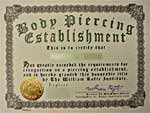
Sample “scam” certificates avaiable from Rafti, available without inspection. BME: You’ve met Rafti in person?CREEPER: Yeah, he came in here and looked around. But there wasn’t a piercer here at the time when he came in.
BME: There was no piercer working?
CREEPER: Nope.
BME: And I guess you can’t really vouch for Rafti’s skills or knowledge?
CREEPER: No.
BME: Has he asked you to instruct at his school?
CREEPER: He asked me something about it, but I said “no way”. I’m just not interested in the piercing thing any more. It’s gone way too wild for me! I pierced for ten years and apprenticed a lot of piercers. I don’t even do it any more. I just tattoo now.
Well, that’s the end of Rafti’s industry references.
Getting in touch with John Seaton of the Suffolk County Health Department was extremely difficult — I called for days, every few hours, and no one was able to ever find him (even Rafti had warned me that he was extremely busy). On my last day of research, when I was ready to write off Seaton as unreachable, he answered and I was able to ask him about Rafti’s credentials.
BME: Do you know William Rafti?
SEATON: I have a disc [from him]; he gave me a disc but I haven’t looked at it yet.
BME: He told me you would vouch for him as a piercing instructor…
SEATON: [laughing]
BME: …and that you’d been waiting 20 years for something like this to happen?
SEATON: [laughing hysterically] …You know, I hate to tell you: the guy came in, he showed a bill of goods, and I looked at him and it just sounded too fishy. You know when something appears to be too good to be true?
BME: He says you trained him and endorse him as qualified?
SEATON: [laughs] He may have been through my certification course and earned a certificate.
BME: What does that course involve?
SEATON: Knowledge of bloodborne pathogens. I teach a little course — a couple hours.
BME: So it’s not something that qualifies someone as a piercer; it just covers the basics of contamination control and so on?
SEATON: Yes — that’s all we can certify. As to skill as a piercer, the law doesn’t address that.
I’m sure no one is shocked at this point, but Rafti’s claims to be endorsed by the Suffolk County Board of Health as a piercer let alone an instructor are stretching the truth pretty thin. He simply took the afternoon bloodborne pathogens course offered by the county to anyone who wants to take it.
So what of Rafti’s lofty credentials? Perhaps he’d at least tell me where his degree was issued — after all, he was claiming not only to be a dude writing a book, but also a scientific researcher (he made the preposterous claim that soaking a piece of body jewelry in brine solution could detect how well it would fare in the body — anyone with even basic knowledge of implant standards as they apply to metallurgy and biology knows the notion is foolish).
BME: You claim to be an expert in this field — what is your actual experience that backs that up?
RAFTI: Thanks for implying that I’m an expert, you can also call me handsome if you want. I claim to be what I already said.
BME: I didn’t imply that you’re an expert, and you didn’t answer my question. Anyway, have you done other research-oriented writing that prepared you for this book?
RAFTI: I’ve written for other publications that would not like being associated with piercing or tattooing in any way, shape, or form so I will not mention them. I have a wall full of credentials — I have credentials for all kinds of things. My mentor, who’s name I am not going to mention, was an international attorney.
I studied anatomy — but don’t quiz me on it. I took a first aid course but my certification expired, and I was certified to run an air compressor.
BME: Ah, so you’re “qualified”, but it’s a secret. I see. In your book you say that you are a piercer and a tattoo artist. Who trained you and where have you worked?
RAFTI: I worked “underground”. The people who I’ve pierced came to me because they thought I would do a good job, distrusted the local studio, and gave me lots of understanding when things occasionally didn’t go as hoped.
I was strongly encouraged to go into piercing professionally — one of the studios that was going to hire me (no apprenticeship) instructed me to answer the phone by saying “Hello asshole, this is asshole speaking, what do you want?”
I will be doing a few tattoos within the next year on people who don’t care if it comes out right. [Editor’s note: That is not a typo — he actually said this!]
BME: Um… Ok. Sounds like you have high standards. So how many piercings have you actually done?
RAFTI: I’ve done about seventy to seventy-five actual piercings on living people and currently have no plans to do any more.
BME: So what makes you qualified to design and run a piercing school, let alone have the egomania to call it “the most advanced piercing course” available?
RAFTI: I’ve done at least seventy piercings, and I wrote my ebook.
BME: Whether you wrote that ebook or not is for the courts to decide. Anyway, have you ever even seen or attended any of the other courses available?
RAFTI: I have not received piercing certificates from any place other than myself, and that was a conscious decision based on my personal beliefs. I do have a proficiency test of my own creation but it is proprietary.
BME: How many students have taken your course?
RAFTI: None.
BME: Sounds successful… so basically, you can’t tell me anything about your imaginary school (or your credentials to run it), other than it’s the best, but the proof is top secret?
RAFTI: I will divulge the collagen aspect of my “most advanced piercing course”. What I am working with is so new that it doesn’t really have a name — I call it a “Matrix Resistance Simulator”. The trick to simulating mucosa surface lies in growing a kombuka hongo into a proprietary substrate matrix under a steady temperature. By using different frequencies of temperature change various densities can be achieved.
The advantage of my Matrix Resistance Simulator is that although it is very much like skin it is instantly self healing — unfortunately it can dry out to a scab-like crust long before it gets pierced to pieces, [so] it is best to keep it covered with saran wrap between uses. My program involves practicing the techniques in sets like a weightlifter does — can you do it ten times in a row without making a mistake? Can you perform a random series of piercings? I don’t want to see anyone piercing a person until they find their inner grace. It’s best that if a student can’t develop the eye-hand coordination that they fail.
BME: Well that’s about the goofiest training idea I’ve ever heard. It doesn’t make any sense at all — and there’s no such thing as “kombuka hongo”, so you may want to check with your alien advisors on that.
Do you even have any piercings?
RAFTI: That’s a rude question. I have one piercing, an 8ga frenum. I did pierce my ear once with a sewing needle, and with a thumb tack, and also with a staple. I also used an ear piercing gun.
Would you want a brain surgeon who’s never undergone surgery on his own brain to operate on you?
BME: You’re comparing apples and oranges — that analogy doesn’t make sense. A better question would be “would you get a massage from a masseuse that’s never had a massage” or “would you go to a restaurant where the chef has never tasted food?”
RAFTI: Thanks for contributing your own false analogy.
BME: Thanks for avoiding the question. Let’s move on. Ignoring the issues of your total incompetence in running it, if you have plans to run a legitimate piercing school, why do you sell “professional piercer, certified by the William Rafti Institute” certificates to anyone with $15?
RAFTI: I am also willing to make custom certificates for shops that offer their own training — the shop gets their name on their own certificate!
BME: But doesn’t that kind of invalidate the whole legitimacy of your potential school?
RAFTI: I believe that most of the piercers out there are qualified whether they have official certification or not. I believe piercing certificates are modern day talismans — they tend to bring on a desired calming effect that leads to better results. I believe that it is part of our tribal instinct to require talismans, as they enrich and empower us.
BME: Um… OK… You have to understand that it’s getting harder and harder not to laugh at your every response… So why have a school at all then if piercers are already mostly qualified, and all it takes to make them better is hanging up the magic “talisman” certificate you offer? Do the students even need you then?
RAFTI: When the students are ready the teacher will appear, or when the teacher is ready the students will appear — either way works for me.
BME: Now I understand, sensei. “If you build it, they will come.”
|
Now, I want to be very clear on one thing: I don’t think Rafti is an idiot. In fact, I think if you can ignore his overwhelming and eclipsing mental — and ethical — problems, he’s a lot sharper than many would give him credit for. He just happens to be crazy, and not in a good way. When I asked Rafti a question set that I ask of people who ask to become part of BME’s QOD staff he did far better than I expected he would — no better than the average piercer, and with some deranged rants thrown in, but better than I expected:
BME: “I have a 6 ga Prince Albert. I was interested in getting it changed to an apadravya, but both the piercers at the studio I go to say that isn’t possible — can you think of any reason why that would be?”
RAFTI: It’s possible that the studio is not comfortable using a 6 ga needle. Some studios prefer to go no thicker than 8 ga. You should give them a call or stop by the studio and ask them your question. Try to establish better communications with these piercers, you might learn a lot.
Another possibility is that your PA was pierced too close (shallow) to the tip of the penis, making proper placement of a apadravya impossible. A PA is normally placed about 5/8” to 3/4” back from head. Sometimes a studio may hesitate to tell you that you had your PA pierced too shallow out of fear that they might be insulting another piercer’s work. You might want to consider asking your piercer if it would be a better idea to do the apadravya behind the PA.
BME: Good answer, although I don’t think I’ve ever heard of a piercer trying to avoid saying something bad about another’s work.
Next question: “I have my nipples pierced right now (healed) and I wanted to get a second set. I wanted to get the second barbell nice and deep, so the old one pierces the full width of the nipple tip, and the new one pierces the full width of the areola. Would that work?”
RAFTI: I find the “pierces the full width of the nipple tip” part of the statement confuses me, but I think I understand the question. It could work, but only if your nipples are large enough. You don’t state whether both piercings are going to be aligned the same (horizontal or vertical). You are more likely to have enough room if the second piercing is done at opposing angles to your existing piercing, this is especially true if you prefer to wear barbells.
BME: Actually, this is a horrible idea — when you pierce a nipple this deep, you risk damaging and blocking milk ducts. In this commonly occuring problem, an infection can be trapped inside the breast (mastitis) and even lead to mastectomy. You really shouldn’t be recommending this depth of piercing to people.
Next question: “My piercer told me there’s aluminum in the jewelry he’s selling (along with titanium). I heard that aluminum exposure can lead to Alzheimer’s Disease… Should I use different jewelry then? Isn’t that a needless risk?”
RAFTI: I have personally tested a number of batches of titanium barbells, including anodized titanium and from my findings believe that titanium is at least equal to 316LVM for inertness.
BME: Well, the medical industry (and the piercing industry) has known for a long time that titanium is far superior to stainless steel for implantation use.
RAFTI: Here is an eye opener, there is a range of acceptable proportions for each alloy, and each batch of metal does not necessarily have the exact same properties as every other made by the “same” recipe. I could teach a seminar on this, it’s got interesting implications for all of us.
BME: Actually, metals made and certified for implant use are manufactured with very rigorous adherence to quality and there are not notable variations between batches.
Next question: “I heard recently that tools can’t be guaranteed sterilized if they’re in a pouch, but everyone says that I should be sure to watch them open the pouch in front of me so I know the tool is just for me… Who’s right?”
RAFTI: Neither, the best way to tell is to look at the sterilization indicator mark on the pouch. Tell the piercer you are a naturally “paranoid” person who doesn’t want to have nightmares weeks from now, and refer to your “phobia” of dirty needles. This will gain the sympathy of any piercer that I’d trust.
Then tell them to show you the mark on an unused pouch (the pouch will be labeled as to what kind of change to expect), and then [do] a visual examination of the sterilization mark on the sterile pouch that will be used in your procedure. If you do not see a distinct difference in color then you should be very concerned that sterilization is not what it should be.
BME: Well, that’s not true at all — those “sterilization marks” (they’re actually heat and pressure indicators) on the pouches are not reliable indicators of sterility.
Next question: “How often does the water in an autoclave need to be changed?”
RAFTI: It depends on the autoclave. If you are using a Prestige autoclave try not to leave water in it overnight. With many other kinds of self heating autoclaves it’s more important to keep the autoclave properly filled with water than to change it, as this prevents corrosion on the coils.
BME: Not changing the water in an autoclave is extremely dangerous! The endotoxins that build up in the water resevoir survive the sterilization cycle and can contaminate the tools and jewelry.
Next question: “I tend to get really woozy even watching a piercing. I want to get my rook pierced, but I don’t really want to pass out… What can I do to keep this from happening?”
RAFTI: Make sure to eat a meal an hour or so before getting pierced, eat a candy bar, or some sweet cookies (Oreos seem to be a blood bank favorite). Glucose tablets are also helpful for a lot of people, and are easily portable.
There is also a high glucose energy soda available that I saw in the supermarket — it cost $7.50 (US) for a one liter bottle. You might also want to look for this kind of thing in health and nutrition stores. A warning for vegetarians and vegans: glucose is blood sugar.
BME: Are you insane? While the common expression “blood sugar” does refer to glucose levels, glucose is not distilled from blood!
Glucose being made of blood because of the expression “blood sugar”… Classic!
Anyway, not that I think being able to answer these questions decently justifies his glaring theft and deception.
Talking to William Rafti turned out to be one of the biggest wastes of time for me in 2003. That said, while his ravings may seem like a combination of funny, pathetic, and ignorant, there’s actually a danger in lunatics like Rafti being around, especially when they persist in trying to create schools with false and stolen credentials. I realize that the average BME reader can see through him in a second, but not all clients — let alone potential piercers — are that well informed.
It’s often difficult for people to find an apprenticeship, and many people will jump at the opportunity to take part in a sham school like Rafti’s — after all, if you don’t know that it’s stolen, and you’re not familiar with computers, his book could give one the false impression that he is a leading author on the subject (rather than simply identifying him as a nut and a petty thief).
Rafti is a very sad case, because it’s pretty clear after speaking with him that he’s not particularly lucid, and really doesn’t have much of a grasp on reality — there really is a possibility that he genuinely believes that he wrote this book, and that his references check out, and that he has a lofty (albeit top-secret) set of credentials. I’ve been a little split on whether I should even publish this article, because it’s really making me feel like I’m beating up on a mentally handicapped kid (I feel even worse launching legal action against an invalid, but what choice might I have?). When it comes down to it, he is potentially endangering the public — at a minimum he is misleading them and stealing their money (and mine as well I suppose).
In any case, I hope this illustrates how important it is for consumers to be informed — scam artists and liars are rife in this industry (and in many others as well), and they’re not always easy to detect from afar.
Sincerely,

Shannon Larratt
BMEzine.com
Update
After I made it clear to Rafti that I wasn’t going to roll over on the copyright issues, and I informed his distributors and eliminated the majority of his ability to sell the book, he posted the following note on his website’s order page:
On of December 5, 2003 I became aware that some of the material I used in this book was improperly cited, this is very bad for me to have done. Over the last several years I have greatly improved my ability to organize things on the computer; this does not excuse any of the mistakes that I made along the way at all, even if I was unaware that I made them until now.
I sincerely believe that I’m doing very good work here, but I have a greater obligation to properly credit my sources than to add on top of something that obviously “stinks”, for this reason I am no longer making the Body Piercing Encyclopedia available for distribution in any format.
This project can not continue until I properly locate and credit sources that I have plagiarized. The problem in doing this obligatory task is that I have to compare all the information in my book, to all the information that is outside my book- logistically this is impossible for me to do.
If you support what Im trying to do, then I need each and everyone of you to send me any information that you can find of any material that I used without properly citing my source. I simply can not do this all by myself alone any longer, without your help the Body Piercing Encyclopedia Volume 1 is dead.
Please send constructive criticism only (please) to me at [email protected]
I wish to thank Mr. Shannon Larratt of BME for being the first to bring this to my attention, he does a lot of good work, Im sorry that I got some of his work confused with my own.
While I do appreciate that the stolen material is no longer being sold, it’s really “too little, too late”. The fact is that the result of my investigations into the text of the book strongly imply that it is nearly all stolen and from a myriad of sources — most of whom have no idea who Rafti even is (it’s not as if the webmasters of rhinoplasty4you are going to be buying his book). And I’m really not sure I buy his newfound “me so sorry” routine. I just can’t quite convince myself that one can “accidentally” commit fraud on this level and be totally unaware of doing it.
In cases of mass plagiarism it’s not enough to just say “let me know if you see anything stolen” — a request which makes it very clear that Rafti really has no idea where his text starts and the stolen text ends. I came into this review hoping that there would be something salvageable from this book, that my comments would result in improvements. However, I have come to the unavoidable conclusion that this book is rotten to its core and can not be saved.
Then of course there’s the matter of the money — Rafti has potentially made thousands of dollars by selling BME’s and other people’s work as his own. Personally I’m not in it for the money — I’ve always felt that this information should be as free as possible which is why BME/News, BME’s FAQs, glossary, risks, and encyclopedia projects have always been publicly accessible without charge and advertising-free. So while I may be entitled to it, I am not demanding at this moment that Rafti send me his profits. That said, if he wants to ethically purge himself I would encourage him to donate the proceeds to a suitable charity such as The Planetary Society, Antiwar.com, Adopt-a-minefield, or AIDS.org (and provide proof).
My only hope in all of this is that this “tough-love kick-in-the-ass” will help Rafti address these serious issues, both in his research methods and his deception about his potential skills. It’s clear from talking to him that Rafti is a driven individual who desperately wants to produce this project — and that’s a good thing. I do believe that Rafti has a better comprehension of the subject than most, and if he started over from scratch, being careful to properly document his sources, he might actually be able to produce something of real value.
That said, I don’t believe that Rafti is now or ever will be qualified to teach a piercing school and I think it’s a mistake for him to continue pursuing that path. I also think his needless confrontations with influential and integral individuals and organizations in the piercing world are constantly burning bridges and creating enemies where he should instead be fostering alliances and finding people to help him.
I think Wes Wood had the right idea when he said that he supported everyone who was working legitimately. I’m dismayed that Rafti is not. I’ll be surprised if he turns himself and this project around, but still, I hope he does.

